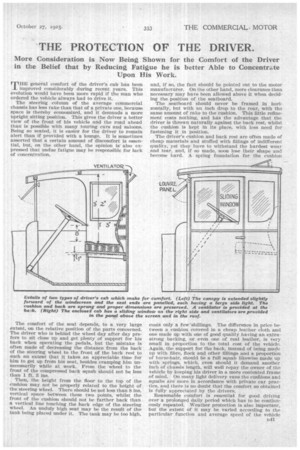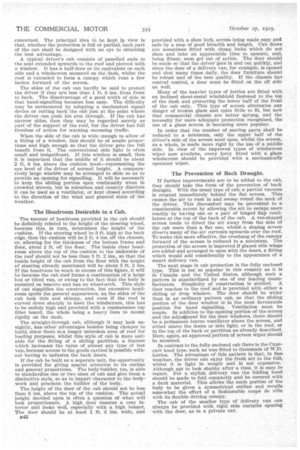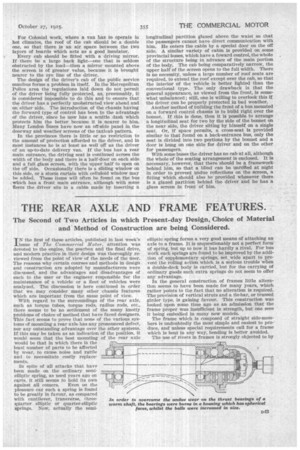THE PROTECTION OF THE DRIVER.
Page 39

Page 40

Page 41

If you've noticed an error in this article please click here to report it so we can fix it.
More Consideration is Now Being Shown for the Comfort of the Driver in the Belief that by Reducing Fatigue he is better Able to Concentrate Upon His Work.
T"general comfort of the driver's cab has been improved considerably during recent years. This evolution would have been more rapid if the man who ordered the vehicle always had to drive it.
The steering column of the average commercial chassis has less rake than that of a private one, because space is thereby economized, and it demands a more upright sitting position. This gives the driver a better view of the front of his vehicle and the road ahead than is possible with many touring cars and saloons. Being so seated, it is easier for the driver to remain alert than if provided with a lounge. It is sometimes asserted that a certain amount of discomfort is essential, but, on the other hand, the opinion is also expressed that undue fatigue may be responsible for lack of concentration.
The comfort of the seat depends, to a very large extent, on the relative position of the parts concerned. The driver who is behind the wheel day after day prefers to sit close up and get plenty of support for his back when operating the pedals, but the mistake is often made of decreasing the distance from the back of the steering wheel to the front of the back rest to such an extent that it takes an appreciable time for him to get up from his seat, besides cramping him unnecessarily while at work. From the wheel to the front of the compressed back squab should not be less than 1 ft. 3 ins.
Then, the height from the floor to the top of the cushion may not be properly related to the height of the steering wheel. There should be not less than 8 ins. vertical space between these two points, whilst the front of the cushion should not be farther back than a vertical line touching the hack edge of the steering wheel. An unduly high seat may be the result of the tank being placed under it. The tank may be too high, and, if so, the fact should be pointed out to the motor manufacturer. On the other hand, more clearance than necessary may have been allowed above it when deciding the position of the seatboard.
The seatboard should never be framed in horizontally, but with an inch drop to the rear, with the same amount of rake to the cushion. This little refinement costs nothing, and has the advantage that the driver is thrown naturally against the back rest, whilst the cushion is kept in its place, with less need for fastening it in position.
The driver's cushion and back rest are often made of cheap materials and stalled with finings of indifferent quality, yet they have to withstand the hardest wear and tear, and, if so made, soon lose their shape and become hard. A spring foundation for the cushion
costs only a few'shillings. The difference in price between a cushion covered in a cheap leather cloth and one made up with one of good quality having an extrastrong backing, or. even one of real leather, is very small in proportion to the total cost of the vehicle. Again, the support for the back, instead of being made up with fibre, flock and other fillings and a proportibn of horse-hair, should be a full squab likewise made up with springs, which, even should it demand another inch of chassis length, will well repay the owner, of the vehicle by keeping his driver in a more contented frame of mind. On many light delivery vans the cushions and squabs are 'more in accordance with private car practice, and there is no doubt that the comfort so obtained is fully appreciated by the drivers.
Reasonable comfort is essential for good. driving over a prolonged daily period which has to be Continu7 ously repeated. Weather protection is also important, but the extent of it may be varied according to the particular function and average speed of the vehicle concerned. The urincipal idea to be kept in view is that, whether the protection is full or.pa:rtial, 'each part of the cab shall be designed with an eye to obtaining the best advantage.
A typical driver's cab consists of panelled ends to the seat extended upwards to the roof and pierced with a window. It has a half-door or its equivalent on each side and a windscreen mounted on the dash, whilst the roof is extended to form a canopy which runs a few inches forward of the screen.
The sides of the cab can hardly be said to protect the driver if they are less than 1 ft. 6 ins, from front to back. The disadvantage of a good width of side is that hand-signalling becomes less easy. The difficulty may be surmounted by adopting a mechanical signal device or cutting back the cab•just at the point where the driver can push his arm through. If the cab has narrow sides, then they may be regarded merely as part of the support of the roof, but the driver has full freedom of action for warning oncoming traffic.
When the side of the cab is wide enough to allow of a fitting of a window, this should be of ample proportions and high enough so that the driver gets the full benefit from it. The conventional side light is often small and insignificant. If this window is small, then it is important that the middle of it should be about 2 ft. 6 ins, above the cushion level—representing the eye level of the driver of normal height. A comparatively large window may be arranged to slide so as to provide an opening for signalling. It will be necessaty to keep the sliding portion open continually when in crowded streets, but in suburban and country districts it can be used as a ventilator, or kept closed according to the direction of the wind and general state of the Iveather.
The Headroom Desirable in a Cab.
The amount of headroom provided in the cab should be definitely related to the height of the steering wheel, because this, in turn, determines the height of the cushion. If the steering wheel be 3 ft. high at the back edge, then the cushion will be 2 ft. 4 ins, off the chassis, or, allowing for the thickness of the bottom frame and floor, about 2 ft. off the floor. The inside clear headroom above the top of the cushion to the underside of the roof should not be less than 3 ft. 2 ins., so that the inside height of the cab from the floor with the height of steering already mentioned will be about 5 ft. 2 ins. If the headroom be much in excess of this figure, it will be because the cab roof forms a continuation of a large box or tilted van, or owing to the fact that the body is mounted on bearers and has no wheel-arch. This style of cab simplifies the construction, but excessive headroom spoils the general appearance, as the sides of the cab look thin and skimpy, and even if the roof is curved down sharply to meet the windscreen, this has to be unduly high and provided with a cumbersome top filler board, the whole being a heavy item to mount rigidly on the dash.
The straight-through cab, although it may lpok unsightly, has other advantages besides being cheaper to build, since there isa longer unbroken area of roof for loading purposes, whilst this style of cab is More suitable for the fitting of a sliding partition, a feature which increases the value of almost any type of box Van, because access to the goods carried is possible without having to unfasten the back doors.
If the cab be built as a separate unit, the opportunity Is provided for giving special attention to its outline and general proportions. The body-builder, too, is able to standardize one or two sizes of cab and give them a distinctive style, so as to impart character to the bodywork and proclaim the builder of the body.
The height of the door of the cab should not be less than 6 ins, above the top of the cushion. The actual height decided upon is often a question of What will look proportionate. A high door ensures a cosy interior and looks well, especially with a high bonnet. The door should be at least 1 ft. 6 ins, wide, and D42 provided with a slam lock, access being made easy and safe by a step of good breadth and length. Cab doors are sometimes fitted with cheap locks which do not slam and take an appreciable time to operate, and, being flimsy, soon get out of action. The door should be made so that the driver' gets in and out quickly, and since the door of a delivery van, for example, is opened and shut many times' daily, the door furniture should be robust and of the best quality. If the chassis has central control, a door must be fitted on the off side as well.
Many of the heavier types of lorries are fitted with an inclined sheet-metal windshield fastened to the top of the dash and protecting the lower• half of the front of the cab only. This type of screen eliminates any danger of broken glass and costs little to fit, but now that commercial chassis are better sprung, and the necessity for more adequate protection recognized, the use of a glass screen is becoming more popular.
In order that the number of moving parts shall be reduced to a minimum, only the upper half of the driver's side of the screen need open, whilst the screen, as a whole, is made more rigid by the use of a middle stile. In view of the improved types of windscreen wiper now availabe, every lorry fitted with a glass windscreen should be provided with a mechanically operated wiper.
The Prevention of Back Draught.
If further improvement are to be added to the cab, they should take the form of the prevention of back draught. With the usual type of cab, a partial vacuum is created immediately behind the flat screen. This causes the air to rush in and sweep round the neck of the driver. This discomfort may be prevented to a considerable extent by allowing the air to escape more readily by having one or a pair of hinged flap ventilators at the top of the back of the cab. A vee-shaped screen tends to direct the air away from the side of the cab more than a flat one, whilst a sloping screen diverts many of the air currents upwards over the roof. To make this more effective, the overhang of the canopy forward of the screen is reduced to a minimum. The protection of the screen is improved if glazed side wings are added and arranged to open with the doors, a fitting which would add considerably to the appearance of a smart delivery van.
The next stage in cab protection is the fully enclosed type. This is not so popular in this country as it is in Canada and the United States, although such a pattern is standardized by one of our leading Manufacturers. Simplicity of construction is stOdied. A door reaches to the red and is provided with either a sliding or drop window. The door should. he wider than in an ordinary pattern cab, so that the sliding portion of the door window is in the most favourable position for hand signalling. Ventilation must be ample. In addition to the opening portion of the screen and the adjustment for the door windows, there should be a peimanent louvre ventilator above the screen, and either above the doors or side light, or in the roof, or in the top of the back or partition as already described. Here, again, an approved pattern of screen wiper should be mounted.
In contrast to the fully enclosed cab there is the Capecart hood type, such as was fitted to thousands of W.D. lorries. The advantage of this pattern is that, in fine weather, the driver can enjoy the fresh air to the full, whilst it is light in weight and is not expensive. Although apt to look shabby, after a time, it is easy to repair. For a stylish delivery van the folding hood should be made to fold compactly and be covered with a dark material. This allows the main portion of the body to be given a symmetrical outline and recalls somewhat the effect of a fashionable coup4 iJe Tine with its flexible driving canopy.
The cab of the smaller type of delivery van can always be provided with rigid side curtains opening , with the door, as in a private car. For Colonial work, where a van has to operate in hot climates, the roof of the cab should be a double one, so that there is an air space between the two layers of boards which acts as a good insulator.
Every cab should be fitted with a driving mirror. If there be a large back light—one that is seldom obstructed by tile load—then a mirror mounted above the screen is of greater value, because it ip brought nearer to the eye line of the driver.
The design of the driver's cab of the public service omnibus forms a problem in itself. In the Metropolitan Police area the regulations laid down do not permit of the driver heing fully protected, as, presumably, it is considered impossible to do this and to ensure that the driver has a perfectly unobstructed view ahead and on either side. The introduction of the chassis having the forward type of control has been to the advantage of the driver, since he now has a scuttle dash which protects him the better because it is nearer to him. Many London huses have now an off-side panel in the doorway and weather screens of the taxicab pattern.
In the provinces there is little or no restriction to the amount of protection afforded to the driver, and in most instances he is at least as well off as the driver of an up-to-date delivery van. If the bus has a rear main entrance, the driving seat is continued across the width of the body and there is a half-door on each side and a full glass screen, with the upper half to open on the off side. Occasionally there is a sliding window on this side, or a storm curtain with celluloid window may be added. These items will often he found on the bus which has a front main entrance, although with some fleets the driver sits in a cabin made by inserting a
longitudinal partition glazed above the waist so that the passengers cannot have direct communication with him. He enters the cabin by a special door on the off side. A similar variety of cabin is provided on some provincial buses, which have a foward control, the whole of the structure being in advance of the main portion of the body. The cab being comparatively narrow, the upper half of the screen opens to the full width. There is no necessity, unless a large number of roof seats are required, to extend the roof except over the cab, so that the interior of the vehicle is better lighted than theconventional type. The only drawback is that the general appearance, as viewed from the front, is somewhat unbalanced ; still, one is willing to overlook this if the driver can be properly protected in bad weather.
Another method of building the front of a bus mounted on a forward control chassis is to build right over the bonnet. If this is done, then it is possible to arrange a longitudinal seat for two by the side of the bonnet on the near side, the driver sitting by himself on a single seat. Or, if space permits, a cross-seat is provided similar to that found on a back-entrance bus, only the seat is divided into two portions by the bonnet and a door is hung on one side for driver and on the other for passengers.
With some buses the driver has no cab at all, although the whole of the seating arrangement is enclosed. It is necessary, however, that there should be a framework behind him, so that a blind can be unrolled at night in order to prevent undue reflections on the screen, a fitting which should also be provided whenever there is a glazed partition behind the driver and he has a glass screen in front of him.




























































